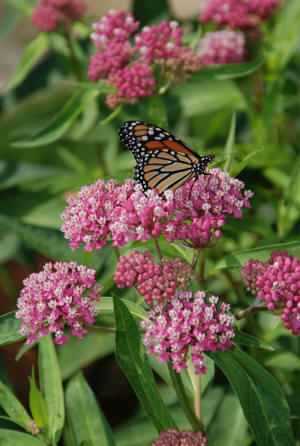|
 Celebrate
the Year of the Asclepias by Planting Milkweed Celebrate
the Year of the Asclepias by Planting Milkweed
By Melinda Myers
 Send a link to a friend
Send a link to a friend
[March 01, 2025]
Grow milkweed (Asclepias) to support monarch
butterflies, hummingbirds, and bees while adding color, fragrance,
and beauty to your landscape. You’ll find native milkweeds
throughout North and South America. In recognition of this garden
star’s attributes, 2025 has been deemed the Year of the Asclepias by
the National Garden Bureau.
With so many to choose from, select the milkweed that is best suited
to the growing conditions, your landscape design, and garden
maintenance. Some milkweeds are very aggressive and can quickly take
over garden beds and large areas in the landscape, requiring time
and effort to maintain their spread. |
|
Butterfly milkweed (Asclepias tuberosa) is one of the
tamer milkweeds with lots of ornamental appeal. This adaptable
milkweed is hardy in zones three to ten and was named the 2017
Perennial Plant of the Year.
Grow butterfly milkweed in full sun with well-drained soil. You’ll
appreciate its drought tolerance once it’s established. If you are
gardening in clay soil, consider growing Asclepias tuberosa var.
clay, a natural variant found growing on clay soil. Mark the
location of any butterfly milkweed in the garden or plant some
spring flowering bulbs nearby to avoid accidentally digging up this
late-to-emerge perennial.
You’ll enjoy the orange blossoms in meadow, prairie, and even
semi-formal gardens. Combine this beauty with yellow, purple, and
blue flowers. Deadhead faded flowers to extend bloom time and
prevent reseeding if this is a concern.
When looking for a bit larger plant that tolerates moist to wet and
occasionally dry soils, check out red milkweed (Syriaca incarnata),
also known as pink and swamp milkweed. You’ll enjoy the fragrant
reddish-pink flowers and the butterflies, bees, and hummingbirds
that visit the flowers.
It’s hardy in zones three to nine plus red milkweed grows three to
five feet tall in upright clumps. The flowers are followed by narrow
pods that release silky-haired seeds like other milkweeds. It grows
best in full sun with moist soil and is less aggressive than common
milkweed. Grow this milkweed in sunny mixed borders, natural
gardens, rain gardens, and alongside ponds. And best of all, the
deer and rabbits tend to leave it, and other milkweeds, be.

[to top of second column] |

Common milkweed Asclepias syriaca is a favorite of
monarchs, hardy in zones three to eight, but very aggressive,
spreading by deep rhizomes and seeds. The purple-pink flowers are
fragrant at night, and you will find a variety of butterflies
stopping by for a visit. Keep it contained by persistently removing
unwanted suckers and seedpods before they open to prevent reseeding.
Sullivant’s milkweed Asclepias sullivantii is similar but a bit
less aggressive. It has the same great butterfly appeal and is hardy
in zones four to seven.
These are just a few of the more than 100 native milkweed species,
many of which you may want to add to your gardens. You can find out
more about the species native to your region in the Milkweed
Regional Guides located on the Xerces Society website. You are sure
to find one or more to add to your garden beds.
Melinda Myers has written more than 20 gardening books,
including the Midwest Gardener’s Handbook, 2nd Edition and Small
Space Gardening. She hosts The Great Courses “How to Grow Anything”
instant video and DVD series and the nationally syndicated Melinda’s
Garden Moment TV & radio program. Myers is a columnist and
contributing editor for Birds & Blooms magazine and was commissioned
by Summit for her expertise to write this article. Myers’ website is www.MelindaMyers.com.
[Photo courtesy of MelindaMyers.com]
|